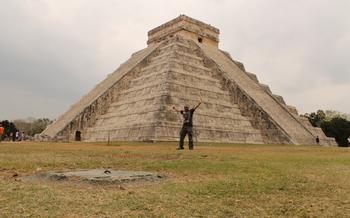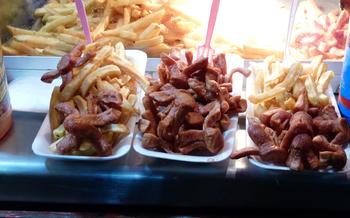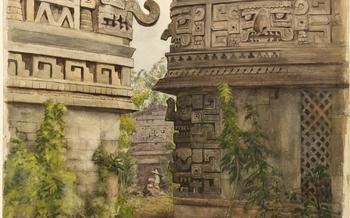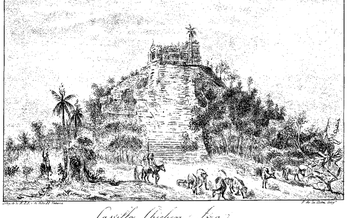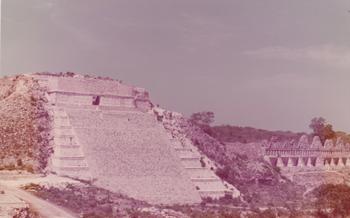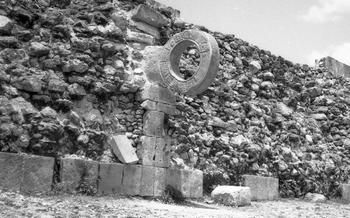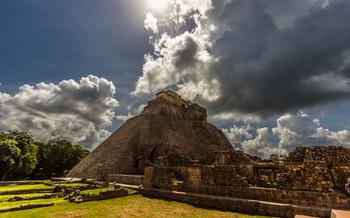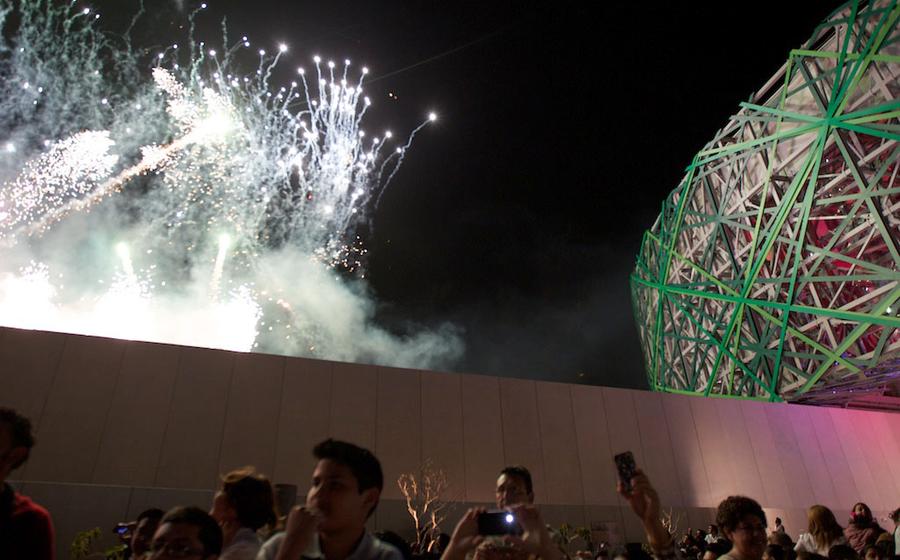
Gran Museo del Mundo Maya
- Exploring the Museum's Galleries: A Multisensory Experience
- Unveiling the Secrets of the Maya: Artifacts and Exhibits
- Immersive Experiences: Virtual Reality and Multimedia Presentations
- Beyond the Museum Walls: Archaeological Sites and Cultural Tours
- Unearthing the Mysteries of the Maya: Workshops and Lectures
- The Museum Shop: A Treasury of Mayan Crafts and Souvenirs
- A Culinary Journey: Mayan Cuisine at the Museum's Restaurant
- Engaging with Mayan Culture: Traditional Performances and Workshops
- Exploring the Museum's Gardens: A Haven of Native Flora
- Unveiling the Wonders of the Maya: Guided Tours and Workshops
- Behind the Scenes: A Glimpse into the Museum's Collections
- Tracing the Steps of the Maya: The Interactive Time Tunnel
- Theoretical Notions
- Informative Content
- Practical Suggestions
- Anecdotes
- Discovering Mayan Wisdom: The Ethnobotanical Garden
- Insider Tip: Enhancing Your Museum Experience
Exploring the Museum's Galleries: A Multisensory Experience
Theoretical Notions: The Gran Museo del Mundo Maya is meticulously organized into various galleries, each focusing on specific themes and curatorial approaches. These galleries take visitors on a chronological journey through Mayan history, from their origins to their cultural and societal developments.
Informative Content: - The Creation Gallery: This gallery introduces the Maya's creation myths and their intricate cosmos. - The Maya Gods Gallery: Here, visitors encounter the diverse pantheon of Mayan deities and their profound influence on daily life and rituals. - The Everyday Life Gallery: This gallery showcases artifacts that provide glimpses into the domestic lives, social structures, and economic activities of the ancient Maya. - The Writing and Calendar Gallery: Discover the fascinating world of Mayan hieroglyphics, their sophisticated calendar system, and their role in recording history and astronomical events. - The Conquest and Colony Gallery: This gallery explores the impact of Spanish conquest on Mayan society, culture, and resistance movements.
Practical Suggestions: - Allow ample time to explore each gallery thoroughly, as each offers a wealth of information and artifacts. - Take advantage of the interactive displays and multimedia presentations to deepen your understanding of Mayan culture. - Follow the suggested routes to ensure a comprehensive visit, but don't hesitate to explore at your own pace.
Anecdotes: - In the Writing and Calendar Gallery, I was captivated by the replica of the Dresden Codex, an ancient Mayan book that provides valuable insights into their complex writing system. - In the Everyday Life Gallery, I was intrigued by a beautifully preserved ceramic figurine depicting a Mayan woman engaged in textile weaving, a skill that remains important in the region today.
Unveiling the Secrets of the Maya: Artifacts and Exhibits
The Gran Museo del Mundo Maya houses a vast collection of artifacts that provide a glimpse into the rich cultural heritage of the Maya. Among the must-see exhibits are the exquisite jade jewelry, intricately carved stelae, and finely painted ceramics. The museum's curators have carefully organized the galleries to showcase the evolution of Mayan art and culture over time.
One of the highlights of the museum is the Funerary Mask of Pakal the Great. This iconic artifact, discovered in the tomb of the Mayan ruler, is made of jade and features an elaborate headdress and intricate carvings. The mask offers a glimpse into the beliefs and rituals surrounding death and the afterlife in Mayan culture.
Another fascinating exhibit is the Dresden Codex, one of the few surviving Mayan books. This ancient manuscript contains astronomical calculations, historical records, and religious rituals. The codex provides valuable insights into the intellectual and scientific achievements of the Maya.
The museum also features interactive displays that allow visitors to engage with the artifacts and learn more about Mayan culture. These interactive experiences include virtual reality tours of Mayan cities, 3D models of artifacts, and hands-on activities for children.
Tips for Appreciating the Artifacts:
- Take your time andじっくりと explore each gallery, paying attention to the details of the artifacts and their descriptions.
- Use the audio guide or join a guided tour to gain deeper insights into the significance of the exhibits.
- Capture memorable photos of the artifacts, but be respectful of the museum's rules and regulations regarding photography.
- Engage with the interactive displays to enhance your understanding of Mayan culture and history.
Immersive Experiences: Virtual Reality and Multimedia Presentations
The Gran Museo del Mundo Maya takes visitors on an immersive journey through Mayan history and culture using cutting-edge technology. Virtual reality experiences transport visitors to ancient Mayan cities, allowing them to explore these lost worlds as if they were there. Multimedia presentations bring Mayan history to life with stunning visuals, captivating narratives, and interactive elements.
The virtual reality experiences are particularly impressive. Visitors can don VR headsets and step into the shoes of a Mayan farmer, experiencing the challenges of daily life in the ancient world. They can soar over the rainforest canopy, marveling at the vastness of the Mayan empire. Or they can descend into a cenote, discovering the secrets of the underworld.
The multimedia presentations are equally engaging. Visitors can learn about the Mayan calendar, the intricate writing system, and the complex religious beliefs through interactive displays and touchscreens. They can watch documentaries about Mayan history and culture, or listen to traditional Mayan music and stories.
These immersive experiences are not just educational but also emotionally impactful. They allow visitors to connect with the Maya on a deeper level, fostering a sense of awe and wonder. Whether you're a history buff, a culture enthusiast, or simply someone looking for a unique and unforgettable experience, the Gran Museo del Mundo Maya's virtual reality and multimedia presentations are not to be missed.
Practical Suggestions:
- Book your virtual reality experience in advance to avoid disappointment.
- Arrive early for your presentation to get a good seat.
- Make sure your VR headset is properly adjusted for a comfortable and immersive experience.
- Don't forget your camera to capture your virtual journey.
Anecdote:
During my visit to the museum, I had the opportunity to experience the virtual reality tour of Chichén Itzá. I was amazed by the realism of the experience. I felt like I was actually walking through the ancient city, marveling at the towering pyramids and intricate carvings. It was an incredible way to learn about Mayan history and culture.
Beyond the Museum Walls: Archaeological Sites and Cultural Tours
To fully immerse yourself in the world of the Maya, venturing beyond the museum walls to explore nearby archaeological sites and cultural attractions is essential. The region surrounding Merida is a treasure trove of ancient ruins, each offering a glimpse into the rich history and diverse cultures of the Maya.
Must-Visit Archaeological Sites:
-
Chichén Itzá: A UNESCO World Heritage Site, Chichén Itzá is renowned for its iconic pyramid El Castillo, also known as the Temple of Kukulkan. Marvel at the architectural marvels, including the Great Ball Court, the Temple of the Warriors, and the Sacred Cenote.
-
Uxmal: Another UNESCO World Heritage Site, Uxmal boasts well-preserved buildings adorned with intricate carvings and sculptures. Don't miss the Governor's Palace, the Pyramid of the Magician, and the Nunnery Quadrangle.
-
Ek Balam: Less crowded than the other sites, Ek Balam offers a more intimate experience. Climb the Acropolis for breathtaking views, explore the cenotes, and admire the impressive stucco masks that decorate the site.
Cultural Tours and Day Trips:
-
Mayan Cooking Class: Learn the secrets of traditional Mayan cuisine in a hands-on cooking class. Prepare dishes using fresh local ingredients and discover the cultural significance of Mayan food.
-
Cenote Adventure: Embark on a refreshing day trip to explore the sacred cenotes of the Yucatán Peninsula. Swim in the crystal-clear waters, admire the unique rock formations, and learn about the Mayan belief system surrounding these natural wonders.
-
Visit a Traditional Mayan Village: Immerse yourself in the vibrant culture of the Maya by visiting a traditional village. Interact with local artisans, learn about their crafts, and gain insights into their way of life.
Unearthing the Mysteries of the Maya: Workshops and Lectures
The Gran Museo del Mundo Maya offers a diverse range of educational programs, including workshops, lectures, and seminars, that delve into the captivating world of Mayan culture and history. These programs are led by renowned experts, scholars, and researchers who share their knowledge and insights with visitors, providing a deeper understanding of the Maya's rich legacy.
Theoretical Notions:
- The museum's educational programs aim to promote cultural preservation, foster dialogue, and encourage critical thinking about Mayan civilization.
- Workshops and lectures cover a wide range of topics, including Mayan art, architecture, hieroglyphics, cosmology, and contemporary Maya culture.
Informative Content:
- Workshops often focus on hands-on activities, allowing participants to engage with Mayan traditions through crafts, cooking, or traditional dance lessons.
- Lectures present cutting-edge research and insights on various aspects of Mayan civilization, delivered by renowned scholars and archaeologists.
- Seminars provide a platform for in-depth discussions and debates on specific topics, encouraging participants to critically engage with Mayan history and culture.
Practical Suggestions:
- Advance booking is recommended for workshops and seminars, especially during peak tourist seasons.
- Check the museum's website or inquire at the information desk for the latest schedule of programs and events.
- Some workshops may require a nominal fee, while others are included with the museum admission ticket.
Anecdotes:
- During a workshop on Mayan hieroglyphics, I had the opportunity to decipher ancient Mayan texts and gain insights into their complex writing system.
- A lecture on Mayan cosmology opened my eyes to the intricate beliefs and rituals that shaped Mayan society's relationship with the cosmos.
- Participating in a traditional Mayan cooking workshop was a delightful experience, as I learned to prepare authentic dishes using ancient recipes and techniques.
The Museum Shop: A Treasury of Mayan Crafts and Souvenirs
The Gran Museo del Mundo Maya's museum shop is a treasure trove of authentic Mayan crafts and souvenirs, offering a unique opportunity to support local artisans and take home a piece of Mayan culture. From vibrant textiles and intricately painted pottery to delicate jewelry and beautifully illustrated books, the shop showcases a diverse range of handmade items that celebrate the region's rich heritage.
Before you embark on your shopping journey, take a moment to learn about the significance of Mayan crafts. Each item tells a story, embodying the skills, traditions, and beliefs of the Maya people. Whether it's a hand-woven hammock, a colorful blouse adorned with traditional embroidery, or a ceramic figurine depicting a Mayan deity, every piece is a testament to the enduring spirit of Mayan culture.
When selecting souvenirs, look for items that are clearly handmade and feature authentic Mayan designs. Bargaining is acceptable and even expected in the shop, so don't be afraid to negotiate a fair price. If you're looking for something truly special, consider purchasing a piece of pottery from the nearby village of Ticul, renowned for its high-quality ceramics.
Remember, by purchasing from the museum shop, you're not only taking home a beautiful souvenir but also contributing to the preservation of Mayan cultural traditions and supporting the livelihoods of local artisans.
A Culinary Journey: Mayan Cuisine at the Museum's Restaurant
The Gran Museo del Mundo Maya not only offers a rich cultural experience but also a culinary journey that allows visitors to savor the authentic flavors of Mayan cuisine. The museum's restaurant, "K'u'uk'" (meaning "food" in the Mayan language), is a culinary gem that showcases traditional Mayan dishes, using fresh, local ingredients and ancient recipes passed down through generations.
The menu features an array of mouthwatering options, including traditional soups like "Sopa de Lima" (lime soup), hearty stews such as "Cochinita Pibil" (slow-roasted pork), and delectable seafood dishes like "Tikin Xic" (fish cooked in achiote sauce). Each dish is lovingly prepared by talented chefs who take pride in preserving the culinary heritage of the Maya.
Beyond the main dishes, "K'u'uk'" offers a variety of appetizers, desserts, and refreshing beverages that reflect the region's unique flavors. From the tangy "Ceviche de Camarón" (shrimp ceviche) to the sweet "Dulce de Papaya" (papaya dessert), every dish is a testament to the richness and diversity of Mayan cuisine.
Dining at "K'u'uk'" is not just about satisfying your taste buds; it's an immersive experience that allows you to connect with Mayan culture through its gastronomy. The restaurant's ambiance is warm and inviting, with traditional Mayan décor and soft music that sets the mood for a memorable meal.
Whether you're a food enthusiast, a history buff, or simply someone who loves to try new flavors, the Gran Museo del Mundo Maya's restaurant is a must-visit destination. It offers a culinary journey that will transport you to the heart of Mayan culture, leaving you with a lasting taste of the region's rich culinary traditions.
Engaging with Mayan Culture: Traditional Performances and Workshops
The Gran Museo del Mundo Maya provides a unique opportunity to engage with Mayan culture through traditional performances and workshops. These immersive experiences offer visitors a glimpse into the rich heritage and living traditions of the Maya people.
Traditional Performances: Witness the vibrant colors and captivating rhythms of traditional Mayan dance performances. These dances, often accompanied by live music, tell stories of Mayan history, mythology, and everyday life. The museum's stage hosts regular performances by renowned Mayan dance troupes, showcasing the diversity and artistry of this ancient tradition.
Workshops: Participate in hands-on workshops that allow you to learn directly from Mayan artisans and craftspeople. Discover the secrets of traditional weaving techniques, create your own pottery using ancient methods, or learn about the medicinal properties of native plants. These workshops provide a meaningful way to connect with Mayan culture and support local artisans.
Insider Tip: To fully immerse yourself in the experience, consider attending a traditional Mayan ceremony or ritual. These ceremonies, often performed by local shamans or spiritual leaders, offer a profound connection to the Maya's spiritual beliefs and practices.
Exploring the Museum's Gardens: A Haven of Native Flora
The Gran Museo del Mundo Maya boasts stunning gardens that provide a tranquil oasis amidst the vibrant city of Merida. These gardens are not merely aesthetic spaces but also serve as a repository of native flora, showcasing the diverse plant life that holds deep significance in Mayan culture.
Theoretical Notions:
The museum's gardens are designed to highlight the importance of native plants in Mayan culture. The Maya had a profound understanding of the medicinal and cultural uses of various plants, integrating them into their daily lives and spiritual practices.
Informative Content:
The gardens are meticulously divided into different sections, each representing a specific ecosystem or theme. Visitors can explore the Arid Zone, Tropical Forest, Medicinal Plant Garden, and Ornamental Plant Garden, among others. Each section features a diverse array of native species, from towering trees to delicate wildflowers.
Practical Suggestions:
To fully appreciate the beauty and significance of the gardens, consider booking a guided tour. Knowledgeable guides will provide insights into the medicinal and cultural uses of the plants, as well as their role in Mayan history and mythology.
Anecdotes:
In one of the gardens, I stumbled upon a magnificent ceiba tree, considered sacred by the Maya. Its towering presence and intricate root system evoked a sense of awe and wonder, reminding me of the deep connection between the Maya and the natural world.
Unveiling the Wonders of the Maya: Guided Tours and Workshops
Guided tours and workshops at the Gran Museo del Mundo Maya offer an immersive and enriching experience for visitors seeking a deeper understanding of Mayan history and culture. Led by knowledgeable guides, these tours provide insights into the museum's vast collections, unraveling the mysteries of the ancient Maya civilization.
Delve into the intricacies of Mayan culture through themed tours that explore specific aspects such as art, architecture, or religion. Learn about the significance of Mayan symbols, decipher hieroglyphs, and discover the stories behind the artifacts. Workshops, on the other hand, provide hands-on experiences, allowing visitors to engage with Mayan traditions. Participate in traditional dance or music workshops, learn about Mayan weaving techniques, or create your own Mayan-inspired crafts.
To make the most of your guided tour or workshop, book in advance to secure your spot, especially during peak tourist seasons. Choose a tour that aligns with your interests, whether it's a general overview or a specialized theme. Don't hesitate to ask questions and engage with the guides, who are passionate about sharing their knowledge of Mayan culture.
Whether you're a history buff, an art enthusiast, or simply curious about the Maya, guided tours and workshops at the Gran Museo del Mundo Maya offer an unforgettable journey into the heart of this ancient civilization.
Behind the Scenes: A Glimpse into the Museum's Collections
Beyond the public galleries, the Gran Museo del Mundo Maya houses an extensive collection of artifacts, documents, and research materials that provide a deeper understanding of Mayan civilization. These collections are not only a valuable resource for researchers and scholars but also offer unique insights for visitors who want to delve deeper into the mysteries of the Maya.
Theoretical Notions: Preserving and studying the museum's vast collections is crucial for advancing our knowledge of Mayan culture. These collections encompass a wide range of artifacts, including ceramics, textiles, jewelry, and stone sculptures, as well as historical documents, photographs, and audiovisual recordings. By carefully preserving and cataloging these items, the museum ensures that they are available for future generations of researchers and scholars to study and learn from.
Informative Content: The museum's collections are organized into several thematic areas, such as archaeology, ethnology, and history. The archaeological collection includes artifacts excavated from various Mayan sites, providing a glimpse into the material culture and daily life of the ancient Maya. The ethnological collection focuses on the contemporary Maya and their traditions, showcasing their textiles, handicrafts, and religious practices. The historical collection documents the history of the Maya region, from the colonial period to the present day.
Practical Suggestions: While the museum's collections are not typically open to the general public, researchers and scholars can request access by submitting a formal proposal to the museum's research department. The museum also offers guided tours of the collections for groups and individuals, providing an opportunity to learn more about the museum's research activities and see some of the artifacts up close.
Anecdotes: During a recent guided tour of the museum's collections, I had the opportunity to examine a rare Mayan codex, a handwritten book containing historical and religious texts. It was an awe-inspiring experience to hold this ancient manuscript in my hands and imagine the stories it contained. The tour guide explained the complex writing system used by the Maya and the significance of the codex in understanding their culture. It was a truly unforgettable moment that deepened my appreciation for the richness and complexity of Mayan civilization.
Tracing the Steps of the Maya: The Interactive Time Tunnel
The Gran Museo del Mundo Maya takes visitors on an awe-inspiring journey through time with its state-of-the-art interactive time tunnel. This captivating experience transports you back in history, allowing you to witness the rise and fall of the Mayan civilization through immersive visuals and engaging storytelling.
Theoretical Notions
The time tunnel utilizes cutting-edge technology to create a seamless and immersive experience. It combines 3D projections, surround sound, and interactive displays to bring the past to life. Visitors can explore different periods of Mayan history, from their humble beginnings to their rise as a powerful civilization and their eventual decline.
Informative Content
The time tunnel covers a vast timeline, starting from the Preclassic period (2000 BC - 250 AD) and extending to the Postclassic period (900 AD - 1519 AD). Each era is vividly depicted, showcasing significant events, cultural practices, and architectural achievements. Visitors can learn about the origins of the Maya, their interactions with neighboring cultures, and the factors that contributed to their rise and fall.
Practical Suggestions
To fully immerse yourself in this experience, take your time and explore each section thoroughly. Pay attention to the detailed animations, captivating sound effects, and interactive elements that enhance the storytelling. Capture memorable moments by taking photos or videos, but remember to respect the museum's guidelines.
Anecdotes
Stepping into the time tunnel felt like being transported back in time. I was particularly moved by the segment depicting the construction of the ancient city of Chichén Itzá. The visuals were so realistic that I could almost feel the weight of the stones and the determination of the Mayan builders. It was a truly awe-inspiring experience that brought history to life in a way that no textbook could.
Discovering Mayan Wisdom: The Ethnobotanical Garden
The Ethnobotanical Garden at the Gran Museo del Mundo Maya offers a unique opportunity to explore the deep connection between the Maya and their natural environment. Wander through lush trails showcasing a diverse collection of plants that hold deep cultural and medicinal significance. The garden serves as a living testament to the Maya's profound understanding of the natural world and their sustainable practices.
Discover the secrets of ancient Mayan medicine as you learn about the healing properties of various plants. Admire the vibrant colors and intricate shapes of flowers that were used for both medicinal and ceremonial purposes. Stroll past towering trees that provided sustenance and shelter to the Maya, and uncover the stories behind their traditional uses.
Guided tours are available to provide deeper insights into the garden's flora and its importance to Mayan culture. Engage with knowledgeable guides who will share fascinating stories and anecdotes about the plants, their medicinal applications, and their role in Mayan rituals and ceremonies.
Take your time to explore the garden, capturing the beauty of the plants and the tranquility of the surroundings. Whether you're a nature enthusiast, a student of ethnobotany, or simply someone curious about Mayan culture, the Ethnobotanical Garden offers a rich and immersive experience that will leave you with a newfound appreciation for the Maya's wisdom and their connection to the earth.
Insider Tip: Enhancing Your Museum Experience
To make the most of your visit to the Gran Museo del Mundo Maya, consider these insider tips:
- Plan your visit for a weekday morning: Avoid the weekend crowds and enjoy a more tranquil experience.
- Start with the Virtual Reality Experience: Begin your journey by immersing yourself in the virtual reality exhibit to gain a captivating overview of Mayan history and culture.
- Take advantage of the guided tours: Join a guided tour to delve deeper into the museum's collection and gain insights from knowledgeable experts. Tours are available in Spanish and English.
- Don't miss the Ethnobotanical Garden: Explore the garden after your museum visit to learn about the Maya's connection to nature and their use of plants for medicinal and cultural purposes.
- Capture the beauty: The museum offers stunning photographic opportunities. Capture the intricate details of the artifacts, the vibrant colors of the gardens, and the awe-inspiring architecture.
- Dine at the museum's restaurant: Indulge in delicious Mayan cuisine at the museum's restaurant, which offers a delightful menu of traditional dishes and refreshing beverages.
- Explore the museum shop: Support local artisans by purchasing unique souvenirs and handmade crafts at the museum shop. You'll find a variety of textiles, pottery, jewelry, and books to choose from.
- Venture beyond the museum: Take the opportunity to explore the vibrant city of Merida and its surrounding areas. Discover historic landmarks, indulge in local delicacies, and immerse yourself in the rich culture of the Yucatan Peninsula.
